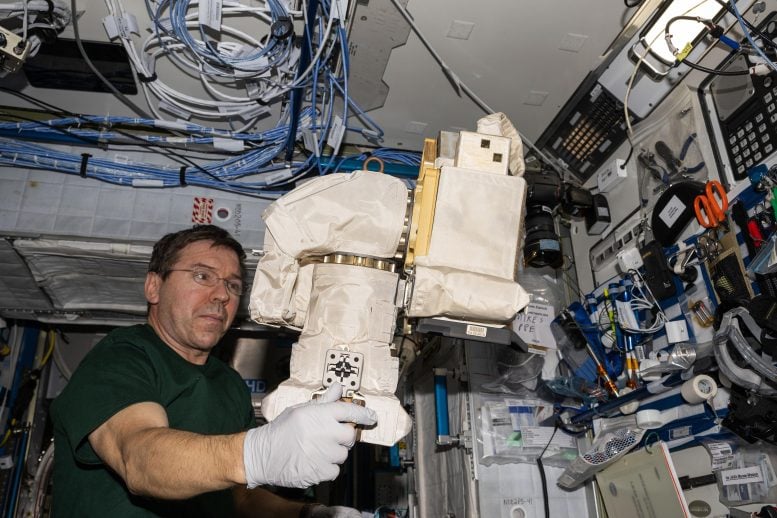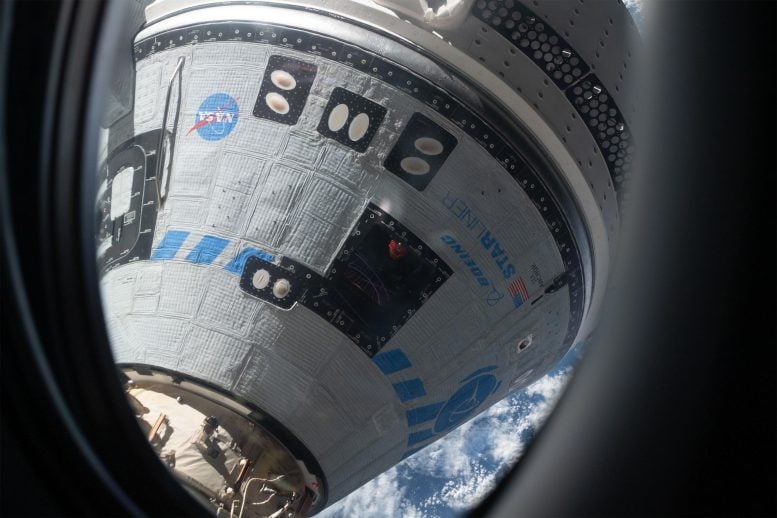Dragon Spacecraft Emergency Training for Astronauts and Cosmonauts Aboard ISS


NASA astronaut and Expedition 71 Flight Engineer Mike Barratt works on spacewalking hardware aboard the International Space Station’s Unity module. Credit: NASA
Astronauts and cosmonauts on the International Space Station engaged in life science studies and routine maintenance tasks.
Key activities included biological sample collection, robotic experiments, and the inspection of life support systems. Crew members also reviewed emergency procedures and participated in physical fitness tests, all while NASA’s Johnson Space Center managed operational challenges due to Hurricane Beryl.
The prime tasks aboard the International Space Station (ISS) on Tuesday, July 9, were life science and docked spacecraft training. The nine orbital residents also split their day on a variety of maintenance tasks including spacesuit work and orbital plumbing.
Human Physiology Research in Space
NASA astronauts Tracy C. Dyson and Matthew Dominick began their day collecting biological samples and data to understand how living in weightlessness affects the human body. Dyson first processed her saliva samples and stowed them in a science freezer for later analysis. She then attached an acoustic monitor near her ear to measure station noise levels a crew member experiences in a 24-hour period. Dominick removed brain wave sensors from his ears that recorded his sleep patterns before filling out a questionnaire documenting his sleep quality.

The SpaceX Dragon Endeavour spacecraft is pictured docked to the space-facing port on the International Space Station’s Harmony module. Credit: NASA
Robotics and Spacecraft Maintenance Activities
Dyson also worked in the Columbus laboratory module and studied the ability to remotely control robots on a planetary surface from a spacecraft for the Surface Avatar experiment. Dominick spent the afternoon in the Tranquility module checking the performance of components in the waste and hygiene compartment, the orbital outpost’s bathroom.
Spacesuit Management and Safety Procedures
NASA Flight Engineer Jeanette Epps photographed Dyson during her robotics experiment. She then spent the afternoon reconfiguring life support gear before removing batteries from spacesuits at the end of the day. NASA Flight Engineer Mike Barratt started his day inspecting spacesuit safety jetpacks that would be used to maneuver safely back to the station in the unlikely event a spacewalker became untethered from the orbital lab.

Boeing’s Starliner spacecraft docked to the Harmony module of the International Space Station on the company’s Orbital Flight Test-2 mission. Credit: NASA
Emergency Procedures and Aerobic Testing
Epps and Barratt also joined Dominick and Roscosmos Flight Engineer Alexander Grebenkin midday and reviewed standard SpaceX Dragon Endeavour spacecraft emergency undocking procedures. The SpaceX Crew-8 quartet docked to the station on March 5 and is due to return to Earth aboard Endeavour in late August.
NASA astronauts Butch Wilmore and Suni Williams, representing Boeing’s Crew Flight Test, took turns during the morning pedaling on an exercise cycle while attached to heart and breathing sensors that measured their aerobic capacity. The duo then split up as Wilmore serviced a pair of research freezers that preserve scientific samples and Williams installed hardware on an experiment that is exploring atmospheric reentry and thermal protection systems.

A trio of lakes in the Ethiopian Rift Valley were pictured from the International Space Station as it orbited 259 miles above. From left are Lakes Shala, Abijatta (both alkaline bodies of water), and Langano, which gets its brown color from high sulfur levels and other minerals. Credit: NASA
Cosmonauts’ Daily Schedule and Safety Precautions
The Roscosmos segment’s three cosmonauts including Grebenkin had their day packed with continuing space research and laboratory upkeep duties. Expedition 71 Commander Oleg Kononenko spent the morning working on ventilation systems in the Nauka science module then completed his day studying futuristic spacecraft and robotic piloting techniques. Flight Engineer Nikolai Chub replaced life support gear in the Zarya module and then joined Grebenkin for a photographic inspection of panels inside the Zvezda service module. Grebenkin earlier jogged on a treadmill for a regularly scheduled physical fitness test.
NASA’s Ground Operations During Hurricane Beryl
NASA’s Johnson Space Center remained closed to all but essential personnel today following Hurricane Beryl’s landfall near Matagorda, Texas. Mission Control continues to support the International Space Station and NASA’s Boeing Crew Flight Test mission. If employees feel safe to do so, the center will be open for on-site work beginning Wednesday.


